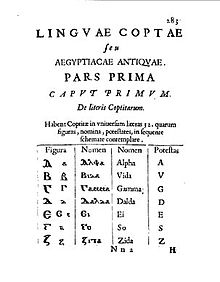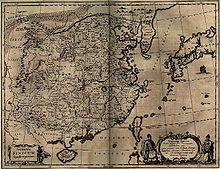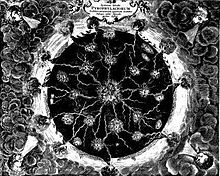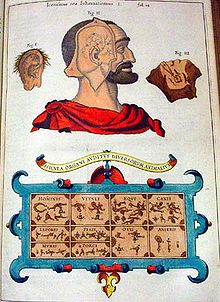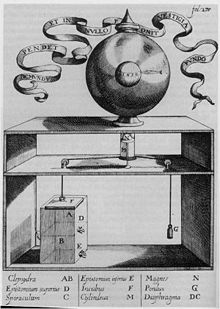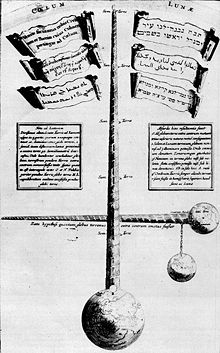- Athanasius Kircher
-
Athanasius Kircher 
Portrait of Kircher from Mundus Subterraneus, 1664Born 2 May 1601 or 1602
Geisa, Abbacy of FuldaDied 27 November or 28 November 1680
RomeNationality German Religion Roman Catholicism (Jesuit scientist-priest)[1] Athanasius Kircher (1601 or 1602 – 1680) (sometimes erroneously spelled Kirchner) was a 17th century German Jesuit scholar who published around 40 works, most notably in the fields of oriental studies, geology, and medicine. Kircher has been compared to fellow Jesuit Roger Boscovich and to Leonardo da Vinci for his enormous range of interests, and has been honoured with the title "master of a hundred arts".[2]
Kircher was the most famous "decipherer" of hieroglyphs of his day, although most of his assumptions and "translations" in this field have since been disproved as nonsensical. However, he did make an early study of Egyptian hieroglyphs, correctly establishing the link between the ancient Egyptian language and the Coptic language, for which he has been considered the founder of Egyptology. He was also fascinated with Sinology, and wrote an encyclopedia of China, in which he noted the early presence of Nestorian Christians but also attempted to establish more tenuous links with Egypt and Christianity.
Kircher's work with geology included studies of volcanos and fossils. One of the first people to observe microbes through a microscope, he was thus ahead of his time in proposing that the plague was caused by an infectious microorganism and in suggesting effective measures to prevent the spread of the disease. Kircher also displayed a keen interest in technology and mechanical inventions, and inventions attributed to him include a magnetic clock, various automatons and the first megaphone. The invention of the magic lantern is often misattributed to Kircher, although he did conduct a study of the principles involved in his Ars Magna Lucis et Umbrae.
A scientific star in his day, towards the end of his life he was eclipsed by the rationalism of René Descartes and others. In the late 20th century, however, the aesthetic qualities of his work again began to be appreciated. One modern scholar, Alan Cutler, described Kircher as "a giant among seventeenth-century scholars", and "one of the last thinkers who could rightfully claim all knowledge as his domain".[3] Another scholar, Edward W. Schmidt, referred to Kircher as "the last Renaissance man".
Contents
Life
Kircher was born on 2 May in either 1601 or 1602 (he himself did not know) in Geisa, Buchonia, near Fulda, currently Hesse, Germany. From his birthplace he took the epithets Bucho, Buchonius and Fuldensis which he sometimes added to his name. He attended the Jesuit College in Fulda from 1614 to 1618, when he joined the order himself as a seminarian.
The youngest of nine children, Kircher studied volcanoes for his passion of rocks and eruptions. He was taught Hebrew by a rabbi[citation needed]in addition to his studies at school. He studied philosophy and theology at Paderborn, but fled to Cologne in 1622 to escape advancing Protestant forces.[citation needed] On the journey, he narrowly escaped death after falling through the ice crossing the frozen Rhine— one of several occasions on which his life was endangered. Later, travelling to Heiligenstadt, he was caught and nearly hanged by a party of Protestant soldiers.[citation needed]
From 1622 to 1624 Kircher stayed in Koblenz as a teacher. At Heiligenstadt, he taught mathematics, Hebrew and Syriac, and produced a show of fireworks and moving scenery for the visiting Elector Archbishop of Mainz, showing early evidence of his interest in mechanical devices. He joined the priesthood in 1628 and became professor of ethics and mathematics at the University of Würzburg, where he also taught Hebrew and Syriac. From 1628, he also began to show an interest in Egyptian hieroglyphs.
Kircher published his first book (the Ars Magnesia, reporting his research on magnetism) in 1631, but the same year he was driven by the continuing Thirty Years' War to the papal University of Avignon in France. In 1633, he was called to Vienna by the emperor to succeed Kepler as Mathematician to the Habsburg court. On the intervention of Nicolas-Claude Fabri de Peiresc, the order was rescinded and he was sent instead to Rome to continue with his scholarly work, but he had already set off for Vienna.
On the way, his ship was blown off-course and he arrived in Rome before he knew of the changed decision. He based himself in the city for the rest of his life, and from 1638, he taught mathematics, physics and oriental languages at the Collegio Romano for several years before being released to devote himself to research. He studied malaria and the plague, amassing a collection of antiquities, which he exhibited along with devices of his own creation in the Museum Kircherianum.
In 1661, Kircher discovered the ruins of a church said to have been constructed by Constantine on the site of Saint Eustace's vision of Jesus Christ in a stag's horns. He raised money to pay for the church’s reconstruction as the Santuario della Mentorella, and his heart was buried in the church on his death.
Work
Kircher published a large number of substantial books on a very wide variety of subjects, such as Egyptology, geology, and music theory. His syncretic approach paid no attention to the boundaries between disciplines which are now conventional: his Magnes, for example, was ostensibly a discussion of magnetism, but also explored other forms of attraction such as gravity and love. Perhaps Kircher's best-known work today is his Oedipus Aegyptiacus (1652–54) a vast study of Egyptology and comparative religion. His books, written in Latin, had a wide circulation in the 17th century, and they contributed to the dissemination of scientific information to a broader circle of readers. But Kircher is not now considered to have made any significant original contributions, although a number of discoveries and inventions (e.g., the magic lantern) have sometimes been mistakenly attributed to him.[4]
Linguistic and cultural studies
Egyptology
The last known example of Egyptian hieroglyphics dates from AD 394, after which all knowledge of hieroglyphics was lost.[5] Until Thomas Young and Jean-François Champollion found the key to hieroglyphics in the 19th century, the main authority was the 4th century Greek grammarian Horapollon, whose chief contribution was the misconception that hieroglyphics were "picture writing" and that future translators should look for symbolic meaning in the pictures.[6] The first modern study of hieroglyphics came with Piero Valeriano Bolzani's nonsensical Hieroglyphica (1566),[5] but Kircher was the most famous of the "decipherers" between ancient and modern times and the most famous Egyptologist of his day.[7] In his Lingua Aegyptiaca Restituta (1643), Kircher called hieroglyphics "this language hitherto unknown in Europe, in which there are as many pictures as letters, as many riddles as sounds, in short as many mazes to be escaped from as mountains to be climbed".[7] While some of his notions are long discredited, portions of his work have been valuable to later scholars, and Kircher helped pioneer Egyptology as a field of serious study.
Kircher's interest in Egyptology began in 1628 when he became intrigued by a collection of hieroglyphs in the library at Speyer. He learned Coptic in 1633 and published the first grammar of that language in 1636, the Prodromus coptus sive aegyptiacus. Kircher then broke with Horapollon's interpretation of the language of the hieroglyphs with his Lingua aegyptiaca restituta. Kircher argued that Coptic preserved the last development of ancient Egyptian.[7][8] For this Kircher has been considered the true "founder of Egyptology", because his work was conducted "before the discovery of the Rosetta Stone rendered Egyptian hieroglyphics comprehensible to scholars".[8] He also recognised the relationship between the hieratic and hieroglyphic scripts.
 Frontispiece to Kircher's Oedipus Ægyptiacus; the Sphinx, confronted by Kircher's learning, admits he has solved her riddle.
Frontispiece to Kircher's Oedipus Ægyptiacus; the Sphinx, confronted by Kircher's learning, admits he has solved her riddle.
Between 1650 and 1654, Kircher published four volumes of "translations" of hieroglyphs in the context of his Coptic studies.[7] However, according to Steven Frimmer, "none of them even remotely fitted the original texts".[7] In Oedipus Aegyptiacus, Kircher argued under the impression of the Hieroglyphica that ancient Egyptian was the language spoken by Adam and Eve, that Hermes Trismegistus was Moses, and that hieroglyphs were occult symbols which "cannot be translated by words, but expressed only by marks, characters and figures." This led him to translate simple hieroglyphic texts now known to read as dd Wsr ("Osiris says") as "The treachery of Typhon ends at the throne of Isis; the moisture of nature is guarded by the vigilance of Anubis".[citation needed]
Although his approach to deciphering the texts was based on a fundamental misconception, Kircher did pioneer serious study of hieroglyphs, and the data which he collected were later used by Champollion in his successful efforts to decode the script. Kircher himself was alive to the possibility of the hieroglyphs constituting an alphabet; he included in his proposed system (incorrect) derivations of the Greek alphabet from 21 hieroglyphs.[citation needed] However, according to Joseph MacDonnell, it was "because of Kircher's work that scientists knew what to look for when interpreting the Rosetta stone".[9] Another scholar of ancient Egypt, Erik Iverson, concluded:
It is therefore Kircher's incontestable merit that he was the first to have discovered the phonetic value of an Egyptian hieroglyph. From a humanistic as well as an intellectual point of view Egyptology may very well be proud of having Kircher as its founder.[10]Kircher was also actively involved in the erection of obelisks in Roman squares, often adding fantastic "hieroglyphs" of his own design in the blank areas that are now puzzling to modern scholars.[citation needed]
Sinology
Kircher had an early interest in China, telling his superior in 1629 that he wished to become a missionary to the country. In 1667 he published a treatise whose full title was China monumentis, qua sacris qua profanis, nec non variis naturae and artis spectaculis, aliarumque rerum memorabilium argumentis illustrata, and which is commonly known simply as China Illustrata, i.e. "China Illustrated". It was a work of encyclopedic breadth, combining material of unequal quality, from accurate cartography to mythical elements, such as dragons. The work drew heavily on the reports of Jesuits working in China, in particular Michael Boym[11] and Martino Martini.
China Illustrata emphasized the Christian elements of Chinese history, both real and imagined: the book noted the early presence of Nestorian Christians (with a Latin translation of the Nestorian Stele of Xi'an provided by Boym and his Chinese collaborator, Andrew Zheng)[12], but also claimed that the Chinese were descended from the sons of Ham, that Confucius was Hermes Trismegistus/Moses and that the Chinese characters were abstracted hieroglyphs.
In Kircher's system, ideograms were inferior to hieroglyphs because they referred to specific ideas rather than to mysterious complexes of ideas, while the signs of the Maya and Aztecs were yet lower pictograms which referred only to objects. Umberto Eco comments that this idea reflected and supported the European attitude to the Chinese and native American civilizations;
"China was presented not as an unknown barbarian to be defeated but as a prodigal son who should return to the home of the common father". (p. 69)
Biblical studies and exegesis
In 1675, he published Arca Noë, the results of his research on the biblical Ark of Noah— following the Counter-Reformation, allegorical interpretation was giving way to the study of the Old Testament as literal truth among Scriptural scholars. Kircher analyzed the dimensions of the Ark; based on the number of species known to him (excluding insects and other forms thought to arise spontaneously), he calculated that overcrowding would not have been a problem. He also discussed the logistics of the Ark voyage, speculating on whether extra livestock was brought to feed carnivores and what the daily schedule of feeding and caring for animals must have been.
Other cultural work
Kircher received a copy of the Voynich Manuscript in 1666; sent to him by Johannes Marcus Marci in the hope of Kircher being able to decipher it.[13] The manuscript remained in the Collegio Romano until Victor Emmanuel II of Italy annexed the Papal States in 1870, though scepticism as to the authenticity of the story and of the origin of the manuscript itself exists. In his Polygraphia nova (1663), Kircher proposed an artificial universal language.
Physical sciences
Geology
On a visit to southern Italy in 1638, the ever-curious Kircher was lowered into the crater of Vesuvius, then on the brink of eruption, in order to examine its interior. He was also intrigued by the subterranean rumbling which he heard at the Strait of Messina. His geological and geographical investigations culminated in his Mundus Subterraneus of 1664, in which he suggested that the tides were caused by water moving to and from a subterranean ocean.
Kircher was also puzzled by fossils. He understood that some were the remains of animals which had turned to stone, but ascribed others to human invention or to the spontaneous generative force of the earth. He ascribed large bones to giant races of humans.[14] Not all the objects which he was attempting to explain were in fact fossils, hence the diversity of explanations. He interpreted mountain ranges as the Earth's skeletal structures exposed by weathering.[15]
Biology
In his book Arca Noë, Kircher argued that after the flood new species were transformed as they moved into different environments, for example, when a deer moved into a colder climate, it became a reindeer. Additionally, he held that many species were formed by hybrids of other species, for example, the armadillo from a combination of turtles and porcupines. He also advocated the theory of spontaneous generation. [16] Because of such hypotheses, some historians have held that Kircher was a proto-evolutionist. [17]
Medicine
Kircher took a notably modern approach to the study of diseases, as early as 1646 using a microscope to investigate the blood of plague victims. In his Scrutinium Pestis of 1658, he noted the presence of "little worms" or "animalcules" in the blood, and concluded that the disease was caused by microorganisms. The conclusion was correct, although it is likely that what he saw were in fact red or white blood cells and not the plague agent, Yersinia pestis. He also proposed hygienic measures to prevent the spread of disease, such as isolation, quarantine, burning clothes worn by the infected and wearing facemasks to prevent the inhalation of germs.
Technology
In 1646, Kircher published Ars Magna Lucis et Umbrae, on the subject of the display of images on a screen using an apparatus similar to the magic lantern as developed by Christiaan Huygens and others. Kircher described the construction of a "catotrophic lamp" that used reflection to project images on the wall of a darkened room. Although Kircher did not invent the device, he made improvements over previous models, and suggested methods by which exhibitors could use his device. Much of the significance of his work arises from Kircher's rational approach towards the demystification of projected images.[18] Previously such images had been used in Europe to mimic supernatural appearances (Kircher himself cites the use of displayed images by the rabbis in the court of King Solomon). Kircher stressed that exhibitors should take great care to inform spectators that such images were purely naturalistic, and not magical in origin.
Kircher also constructed a magnetic clock, the mechanism of which he explained in his Magnes (1641). The device had originally been invented by another Jesuit, Fr. Linus of Liege, and was described by an acquaintance of Line's in 1634. Kircher's patron Peiresc had claimed that the clock's motion supported the Copernican cosmological model, the argument being that the magnetic sphere in the clock was caused to rotate by the magnetic force of the sun. Kircher's model disproved the hypothesis, showing that the motion could be produced by a water clock in the base of the device. Although Kircher wrote against the Copernican model in his Magnes, supporting instead that of Tycho Brahe, his later Itinerarium extaticum (1656, revised 1671), presented several systems — including the Copernican — as distinct possibilities. The clock has been reconstructed by Caroline Bouguereau in collaboration with Michael John Gorman and is on display at the Green Library at Stanford University.[19].
The Musurgia Universalis (1650) sets out Kircher's views on music: he believed that the harmony of music reflected the proportions of the universe. The book includes plans for constructing water-powered automatic organs, notations of birdsong and diagrams of musical instruments. One illustration shows the differences between the ears of humans and other animals. In Phonurgia Nova (1673) Kircher considered the possibilities of transmitting music to remote places.
Other machines designed by Kircher include an aeolian harp, automatons such as a statue which spoke and listened via a speaking tube, a perpetual motion machine, and a Katzenklavier ("cat piano"). This last of these would have driven spikes into the tails of cats, which would yowl to specified pitches, although Kircher is not known to have actually constructed the instrument.
Combinatorics
Although Kircher's work was not mathematically based, he did develop various systems for generating and counting all combinations of a finite collection of objects (i.e. a finite set). His methods and diagrams are discussed in Ars Magna Sciendi, sive Combinatoria (sic).
Legacy
Scholarly influence
For most of his professional life, Kircher was one of the scientific stars of the world: according to historian Paula Findlen, he was "the first scholar with a global reputation". His importance was twofold: to the results of his own experiments and research he added information gleaned from his correspondence with over 760 scientists, physicians and above all his fellow Jesuits in all parts of the globe. The Encyclopædia Britannica calls him a "one-man intellectual clearing house". His works, illustrated to his orders, were extremely popular, and he was the first scientist to be able to support himself through the sale of his books. Towards the end of his life his stock fell, as the rationalist Cartesian approach began to dominate (Descartes himself described Kircher as "more quacksalver than savant").
Cultural legacy
Kircher was largely neglected until the late 20th century. One writer attributes his rediscovery to the similarities between his eclectic approach and postmodernism:
[Four hundred] years after his birth there is a revival of interest in Kircher, perhaps because Kircher can be considered as the premodern root of postmodern thinking. With his labyrinthine mind, he was Jorge Luis Borges… before Borges. …at the start of the 21st century Kircher's taste for trivia, deception and wonder is back.[20]He added that "Kircher's postmodern qualities include his subversiveness, his celebrity, his technomania and his bizarre eclecticism". In Robert Graham Irwin's For Lust of Knowing, Kircher is called "one of the last scholars aspiring to know everything", with Kircher's contemporary countryman Gottfried Leibniz cited as the probable "last" such scholar.[citation needed]
As few of Kircher's works have been translated, the contemporary emphasis has been on their aesthetic qualities rather than their actual content, and a succession of exhibitions have highlighted the beauty of their illustrations. Historian Anthony Grafton has said that "the staggeringly strange dark continent of Kircher's work [is] the setting for a Borges story that was never written", while Umberto Eco has written about Kircher in his novel The Island of the Day Before, as well as in his non-fiction works The Search for the Perfect Language and Serendipities. The contemporary artist Cybèle Varela has paid tribute to Kircher in her exhibition Ad Sidera per Athanasius Kircher, held in the Collegio Romano, in the same place where the Museum Kircherianum was.
The Museum of Jurassic Technology in Los Angeles has a hall dedicated to the life of Kircher. The Athanasius Kircher Society had a weblog devoted to unusual ephemera, which very occasionally relate to Kircher.[21] His ethnographic collection is in the Pigorini National Museum of Prehistory and Ethnography in Rome.
Bibliography
Kircher's principal works, in chronological order, are:
Year Title Link 1631 Ars Magnesia 1635 Primitiae gnomoniciae catroptricae 1636 Prodromus coptus sive aegyptiacus 1637 Specula Melitensis encyclica, hoc est syntagma novum instrumentorum physico- mathematicorum 1641 Magnes sive de arte magnetica 1643 edition (second ed.) 1643 Lingua aegyptiaca restituta 1645–1646 Ars Magna Lucis et umbrae 1646 edition 1650 Obeliscus Pamphilius: hoc est, Interpretatio noua & Hucusque Intentata Obelisci Hieroglyphici 1650 edition 1650 Musurgia universalis, sive ars magna consoni et dissoni Volumes I and II, 1650 1652–1655 Oedipus Aegyptiacus 1654 Magnes sive (third, expanded edition) 1656 Itinerarium extaticum s. opificium coeleste 1657 Iter extaticum secundum, mundi subterranei prodromus 1658 Scrutinium Physico-Medicum Contagiosae Luis, quae dicitur Pestis 1660 Pantometrum Kircherianum ... explicatum a G. Schotto 1661 Diatribe de prodigiosis crucibus 1663 Polygraphia, seu artificium linguarium quo cum omnibus mundi populis poterit quis respondere 1664–1678 Mundus subterraneus, quo universae denique naturae divitiae Tomus II , 1678 1665 Historia Eustachio-Mariana 1665 edition 1665 Arithmologia sive De abditis numerorum mysterijs 1665 edition 1666 Obelisci Aegyptiaci ... interpretatio hieroglyphica 1667 China monumentis, qua sacris qua profanis, nec non variis naturae and artis spectaculis, aliarumque rerum memorabilium argumentis illustrata Latin edition (1667) (pages with illustrations only); La Chine, 1670 (French, 1670); Modern English translation 1667 Magneticum naturae regnum sive disceptatio physiologica 1668 Organum mathematicum 1669 Principis Cristiani archetypon politicum 1669 Latium 1671 edition 1669 Ars magna sciendi sive combinatorica 1669 edition 1673 Phonurgia nova, sive conjugium mechanico-physicum artis & natvrae paranympha phonosophia concinnatum 1675 Arca Noe 1676 Sphinx mystagoga: sive Diatribe hieroglyphica, qua Mumiae, ex Memphiticis Pyramidum Adytis Erutae… 1676 edition 1676 Obelisci Aegyptiaci 1679 Musaeum Collegii Romani Societatis Jesu 1679 Turris Babel, Sive Archontologia Qua Primo Priscorum post diluvium hominum vita, mores rerumque gestarum magnitudo, Secundo Turris fabrica civitatumque exstructio, confusio linguarum, & inde gentium transmigrationis, cum principalium inde enatorum idiomatum historia, multiplici eruditione describuntur & explicantur. Amsterdam, Jansson-Waesberge 1679. 1679 Tariffa Kircheriana sive mensa Pathagorica expansa 1680 Physiologia Kicheriana experimentalis 1680 edition See also
- List of Jesuit scientists
- List of Roman Catholic scientist-clerics
- Library of Sir Thomas Browne
Notes
- ^ Woods, p 4, 109
- ^ Woods, p 108
- ^ Cutler, p 68
- ^ "Kircher, Athanasius." Encyclopædia Britannica from Encyclopædia Britannica 2007 Ultimate Reference Suite. (2008).
- ^ a b Frimmer, p 37
- ^ Frimmer, p 37-39
- ^ a b c d e Frimmer, p 38
- ^ a b Woods, p 109
- ^ MacDonnell, p 12
- ^ Iverson, p 97-98
- ^ Walravens, Hartmut, Michael Boym und die Flora Sinensis, http://www.haraldfischerverlag.de/hfv/Digital/walravens.pdf
- ^ China Illsutrata; Modern English translation and preface by Dr. Charles D. Van Tuyl
- ^ Tiltman, John H. (Summer 1967). The Voynich Manuscript: "The Most Mysterious Manuscript in the World". XII. NSA Technical Journal. http://www.nsa.gov/public_info/_files/tech_journals/Voynich_Manuscript_Mysterious.pdf. Retrieved October 30, 2011.
- ^ Palmer, Douglas (2005) Earth Time: Exploring the Deep Past from Victorian England to the Grand Canyon. Wiley, Chichester. ISBN 9780470022214
- ^ The Earth - Richard Fortey, Harper Perennial 2004
- ^ O Breidbach, MT Ghiselin (2006) Athanasius Kircher (1602-1680) on Noah's Ark: Baroque "Intelligent Design" Theory, Proceedings of the California Academy of Sciences, Volume 57, No. 36, pp. 991-1002 (http://researcharchive.calacademy.org/research/scipubs/pdfs/v57/proccas_v57_n36.pdf)
- ^ Fairfield Osborn, Henry (1902) From the Greeks to Darwin: An Outline of the Development of the Evolution Idea. MacMillan: London, page 106
- ^ Musser, p 613
- ^ Athanasius Kircher's Magnetic Clock, accessed 23 Apr 2011
- ^ http://www.safran-arts.com/42day/history/h4may/02kirxer.html
- ^ Athanasius Kircher Society Charter
References
- Cutler, Alan (2003). The Seashell on the Mountaintop. New York: Dutton.
- Frimmer, Steven (1969). The stone that spoke: and other clues to the decipherment of lost languages. Putnam.
- Iverson, Erik (1961). The Myth of Egypt and its Hieroglyphs. Copenhagen.
- Ralf Kern: Wissenschaftliche Instrumente in ihrer Zeit. Zweiter Band: Vom Compendium zum Einzelinstrument. 17. Jahrhundert. Verlag der Buchhandlung Walther König 2010, ISBN 978-3-86560-866-6
- MacDonnell, Joseph (1989). Jesuit Geometers. St Louis: Institute of Jesuit Sources.
- Musser, Charles (1990). The Emergence of Cinema: The American Screen to 1907. University of California Press. ISBN 0-520-08533-7.
- Woods, Thomas (2005). How the Catholic Church Built Western Civilization. Washington, DC: Regnery Publishing. ISBN 0-89526-038-7.
Further reading
- Umberto Eco: Serendipities: Language and Lunacy. Columbia University Press (1998). ISBN 0-231-11134-7.
- John Edward Fletcher: A brief survey of the unpublished correspondence of Athanasius Kircher S J. (1602–80), in: Manuscripta, XIII, St. Louis, 1969, pp. 150–60.
- Fletcher, John E. A Study of the Life and Works of Athanasius Kircher, ‘Germanus Incredibilis’. Edited by Elizabeth Fletcher. Brill Publications, Amsterdam, 2011. ISBN13: 9789004207127
- Paula Findlen: Athanasius Kircher: The Last Man Who Knew Everything. New York, Routledge, 2004. ISBN 0-415-94016-8
- John Edward Fletcher: Johann Marcus Marci writes to Athanasius Kircher. Janus, Leyden, LIX (1972), pp. 97–118
- John Edward Fletcher: Athanasius Kircher und seine Beziehungen zum gelehrten Europa seiner Zeit Wolfenbütteler Arbeiten zur Barockforschung, Band 17, 1988.
- John Edward Fletcher: Athanasius Kircher : A Man Under Pressure. 1988
- John Edward Fletcher: Athanasius Kircher And Duke August Of Brunswick-Lüneberg : A Chronicle Of Friendship. 1988
- John Edward Fletcher: Athanasius Kircher And His Correspondence. 1988
- Edward Chaney: "Roma Britannica and the Cultural Memory of Egypt: Lord Arundel and the Obelisk of Domitian", in Roma Britannica: Art Patronage and Cultural Exchange in Eighteenth-Century Rome, eds. D. Marshall, K. Wolfe and S. Russell, British School at Rome, 2011, pp. 147–70
- Godwin, Joscelyn: Athanasius Kircher's Theatre of the World: The Life and Work of the Last Man to Search for Universal Knowledge. Inner Traditions (2009). ISBN 978-159477329-7
- Michael John Gorman, Between the Demonic and the Miraculous: Athanasius Kircher and the Baroque Culture of Machines, unabridged version of essay published in The Great Art of Knowing: The Baroque Encyclopedia of Athanasius Kircher, ed. Daniel Stolzenberg, Stanford: Stanford University Libraries, 2001, pp. 59-70
- Michael John Gorman, The Angel and the Compass: Athanasius Kircher's Magnetic Geography, in Paula Findlen, ed., Athanasius Kircher: The Last Man Who Knew Everything, New York, Routledge, 2004, pp. 229-249
- Caterina Marrone, I geroglifici fantastici di Athanasius Kircher,Viterbo: Nuovi Equilibri, 2002, pp. 166, ISBN 88-7226-653-X.
- Caterina Marrone, Le lingue utopiche,Viterbo: Nuovi Equilibri, 2004 [1995], pp. 338 ISBN 88-7226-815-X.
- Schmidt, Edward W. :The Last Renaissance Man: Athanasius Kircher, SJ. Company: The World of Jesuits and Their Friends. 19(2), Winter 2001–2002.
- Jean-Pierre Thiollet, Je m'appelle Byblos, Paris, H & D, 2005 (p. 254). ISBN 978-2914266048
- Cybèle Varela: Ad Sidera per Athanasius Kircher. Rome, Gangemi, 2008. ISBN 978-88492-1416-1
- Zielinski, Siegfried. Deep Time of the Media. The MIT Press (April 30, 2008) ISBN 978-0262740326. p. 113-157.
- Giunia Totaro, L'autobiographie d'Athanasius Kircher. L'écriture d'un jésuite entre vérité et invention au seuil de l'œuvre. Introduction et traduction française et italienne, Bern: Peter Lang 2009, p. 430 ISBN 978-3-03911-793-2.
- Tiziana Pangrazi, La Musurgia Universalis di Athanasius Kircher, Firenze: Olschki 2009, pp. 206, ISBN 978-88-222-5886-1
External links
Works by Kircher
- Athanasius Kircher Herzog August Bibliothek (Wolfenbütteler Digitale Bibliothek... search for Athanasius Kircher)
- Athanasius Kircher ECHO (European Cultural Heritage Online)
- Athanasius Kircher Max Planck Institut für Wissenschaftsgeschichte
- Athanasius Kircher Gallica
- Athanasius Kircher Titles; Athanasius Kircher as author books.google.com
- Athanasius Kircher archive.org
- Athanasius Kircher Munich Digitisation Centre (MDZ)
- Athanasius Kircher University of Strasbourg
- Arca Noë (1675) in the digital collections of the Linda Hall Library
- An English translation of China Illustrata appearing as an "Appendix" in: Johan Nieuhof, An embassy from the East-India Company of the United Provinces, to the Grand Tartar Cham, emperor of China : delivered by their excellencies Peter de Goyer and Jacob de Keyzer, at his imperial city of Peking wherein the cities, towns, villages, ports, rivers, &c. in their passages from Canton to Peking are ingeniously described by John Nieuhoff ; also an epistle of Father John Adams, their antagonist, concerning the whole negotiation ; with an appendix of several remarks taken out of Father Athanasius Kircher ; Englished and set forth with their several sculptures by John Ogilby (1673),
Sources
- Athanasius Kircher, Dude of Wonders Retrieved Mar. 9, 2009.
- Athanasius Kircher Image Gallery Retrieved Mar. 9, 2009.
- Athanasius Kircher's Magnetic Clock Internet Archive.
- Hans-Josef Olszewsky (1992). Bautz, Friedrich Wilhelm. ed (in German). Kircher, Athanasius. Biographisch-Bibliographisches Kirchenlexikon (BBKL). 3. Herzberg. cols. 1513–1517. ISBN 3-88309-035-2. http://www.bautz.de/bbkl/k/Kircher.shtml.
- Catholic Encyclopedia Retrieved Oct. 16, 2004.
- Glasgow University Library: Musurgia Universalis Retrieved Oct. 16, 2004.
- Infoplease: Athanasius Kircher Retrieved Oct. 16, 2004.
- The Correspondence of Athanasius Kircher Internet Archive
- The Correspondence of Athanasius Kircher. Originals letters Historical Archives of the Pontifical Gregorian University
- The First Use of the Microscope in Medicine Retrieved Oct. 16, 2004.
- The Galileo Project Retrieved Oct. 16, 2004.
- Owners of the Voynich Manuscript Retrieved Feb. 3, 2005.
- The World is Bound With Secret Knots Retrieved Oct. 16, 2004.
- Voynich MS - Biographies Retrieved Oct. 16, 2004.
Further reading
- Fairfield University: Athanasius Kircher
- An extensive subcategorized link directory about A. Kircher
- Geology and A. Kircher (PDF files, in German)
- The Museum of Jurassic Technology in Culver City, California includes models of Kircher's inventions.
- University of Lucerne, Switzerland: Kircher-research project (in German)
- International Bibliography of Athanasius Kircher Research
- Kircherianum Virtuale: A link directory about Kircher and related subjects
- Athanasius Kircher: Contains a short biography, an English translation of Kirchers most wellknown work about the Magic Lantern and of a letter from Kircher to a Swedish prince
- Athanasius Kircher Project at Stanford University. Includes high-quality scans of many illustrations from his books.
- Works by or about Athanasius Kircher in libraries (WorldCat catalog)
Categories:- 1600s births
- 1680 deaths
- People from Geisa
- Christian Hebraists
- German Egyptologists
- German inventors
- German Jesuits
- German music theorists
- German philologists
- German scientists
- German Roman Catholic priests
- German writers
- Coptologists
- Christian Kabbalists
- Roman Catholic cleric–scientists
- Proto-evolutionary biologists
Wikimedia Foundation. 2010.

